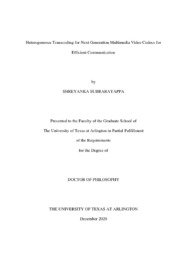
ATTENTION: The works hosted here are being migrated to a new repository that will consolidate resources, improve discoverability, and better show UTA's research impact on the global community. We will update authors as the migration progresses. Please see MavMatrix for more information.
Show simple item record
| dc.contributor.advisor | rao, K. R. | |
| dc.creator | Subbarayappa, Shreyanka | |
| dc.date.accessioned | 2022-01-21T19:35:51Z | |
| dc.date.available | 2022-01-21T19:35:51Z | |
| dc.date.created | 2020-12 | |
| dc.date.issued | 2020-11-30 | |
| dc.date.submitted | December 2020 | |
| dc.identifier.uri | http://hdl.handle.net/10106/30191 | |
| dc.description.abstract | Innovations in the communication systems and technology are growing tremendously and the growth seen is unimaginable in the last forty years. In multimedia communication systems, technology has transformed from analog television to digital television in the video domain. Mobile phones are known as smart phones as they are used, not only to make voice calls, but also used to send emails, video calls, transfer data, GPS, taking pictures and so on. Due to the wide spread user applications, compression on data becomes important to save system resources. Video has occupied 75% of major traffic of data transfer and is expected to cover 80% by 2021 [4]. Video is also continuously increasing in size from standard-definition (SD) to ultra-high definition (UHD - 4K, 8K and 12K) video. More data or size in video requires higher transmission bandwidth or more disk space to store, which is very expensive. This drives into the betterment in compression and hence a demand for a new codec. Several algorithms are implemented to achieve compression of Image or Video with respect to the user’s demand on the quality of output as well as application it is used for. These algorithms working together are classified in terms of codecs and we use different codecs for different applications.
Advances in video compression technology are used to reduce the utilization of system resources, like processing time, memory use, network bandwidth and battery life. This is possible by reducing the complexity of the video codecs without compromising on the output video quality [2][3][5]. There are two distinct lines in the future video coding technology development work. EVC driven by MPEG team [126] and Versatile Video Codec (VVC) [7][8] driven by Joint Video Exploration Team (JVET). These codecs are the extended versions with advances in compression technologies when compared to the prior video codecs or reference codecs HEVC and H.264.
This thesis is fundamentally and entirely devoted to the theory and design of different algorithms used in present and future video codecs to obtain efficient implementation and reconstruction of codec outputs. It also addresses the most recent codecs being developed, i.e. EVC and VVC. Transcoding being one of the main applications in video technologies is implemented and studied between these four codecs. | |
| dc.format.mimetype | application/pdf | |
| dc.language.iso | en_US | |
| dc.subject | VVC | |
| dc.subject | EVC | |
| dc.subject | Transcoding | |
| dc.subject | Video codecs | |
| dc.title | Heterogeneous Transcoding for Next Generation Multimedia Video Codecs for Efficient Communication | |
| dc.type | Thesis | |
| dc.degree.department | Electrical Engineering | |
| dc.degree.name | Doctor of Philosophy in Electrical Engineering | |
| dc.date.updated | 2022-01-21T19:35:52Z | |
| thesis.degree.department | Electrical Engineering | |
| thesis.degree.grantor | The University of Texas at Arlington | |
| thesis.degree.level | Doctoral | |
| thesis.degree.name | Doctor of Philosophy in Electrical Engineering | |
| dc.type.material | text | |
| dc.creator.orcid | 0000-0001-8800-4193 | |
Files in this item
- Name:
- SUBBARAYAPPA-DISSERTATION-2020.pdf
- Size:
- 4.931Mb
- Format:
- PDF
This item appears in the following Collection(s)
Show simple item record


